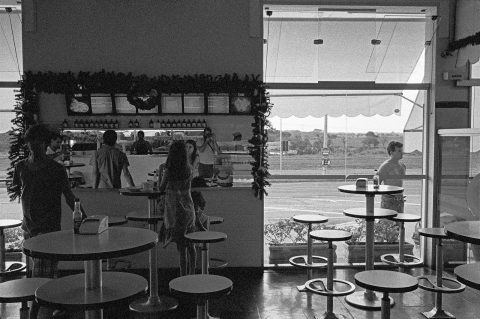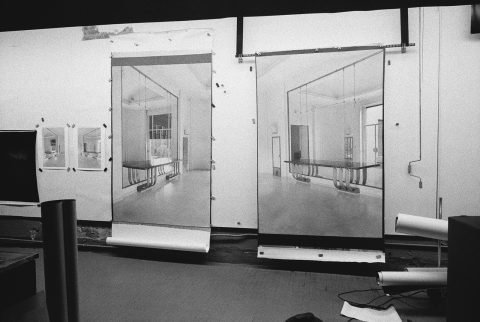Mauro Restiffe, picturing the archive
At Sao Paulo’s Estação Pinacoteca the eminent Brazilian photographer shows hundreds of unpublished pictures and merges them with painting.
- Mauro Restiffe | Álbum Exhibition view at Pina Estação | Pinacoteca do Estado de São Paulo São Paulo, Brazil, 2017. Photos: Eduardo Ortega / Courtesy Fortes D’Aloia & Gabriel.
- Mauro Restiffe, Coqueiral, 2013 Gelatin silver print 70 x 105 cm. Photo: Mauro Restiffe / Courtesy Fortes D’Aloia & Gabriel.
- Mauro Restiffe, Não Vai Ter Golpe, 2016 Gelatin silver print 50 x 75 cm. Photo: Mauro Restiffe / Courtesy Fortes D’Aloia & Gabriel.
- Mauro Restiffe, Interior Landscape, 2012 Gelatin silver print 70 x 105 cm. Photo: Mauro Restiffe / Courtesy Fortes D’Aloia & Gabriel.
- Mauro Restiffe, Parede Branca, 2010 Gelatin silver print 35 x 52,5. Photo: Mauro Restiffe / Courtesy Fortes D’Aloia & Gabriel.
- Mauro Restiffe, Parada, 2011 Gelatin silver print 100 x 150 cm. Photo: Mauro Restiffe / Courtesy Fortes D’Aloia & Gabriel.
- Mauro Restiffe, Gelatin silver print 60 x. 90 cm. Photo: Mauro Restiffe / Courtesy Fortes D’Aloia & Gabriel.
- Mauro Restiffe, Lab Mirrors, 2010 Gelatin silver print 100 x 150 cm. Photo: Mauro Restiffe / Courtesy Fortes D’Aloia & Gabriel.
- Mauro Restiffe, Empossamento Revisitado, 2003 Gelatin silver print 130 x 195 cm. Photo: Mauro Restiffe / Courtesy Fortes D’Aloia & Gabriel.
- Mauro Restiffe, Photograph of Photographs of Photographs, 2013 Gelatin silver print 24 x 36 cm. Photo: Mauro Restiffe / Courtesy Fortes D’Aloia & Gabriel.
- Mauro Restiffe, Calça e Prateleiras, 2001 Gelatin silver print 50 x 50 cm.
- Mauro Restiffe, Lianna e o Seio de Leite, 2002 Gelatin silver print, 45 x 45 cm. Photo: Mauro Restiffe / Courtesy Fortes D’Aloia & Gabriel.
- Mauro Restiffe, Lianna com Toalha em Quarto de Hotel, 2012 Gelatin silver print 35 x 52,5 cm. Photo: Mauro Restiffe / Courtesy Fortes D’Aloia & Gabriel.
- Mauro Restiffe, Matheus na Janela do Navio, 2015 Gelatin silver print 45 x 45 cm. Photo: Mauro Restiffe / Courtesy Fortes D’Aloia & Gabriel.
- Mauro Restiffe, A Mãe e a Branca, 2016 Gelatin silver print 50 x 75 cm. Photo: Mauro Restiffe / Courtesy Fortes D’Aloia & Gabriel.
- Mauro Restiffe | Álbum Exhibition view at Pina Estação | Pinacoteca do Estado de São Paulo São Paulo, Brazil, 2017. Photos: Eduardo Ortega / Courtesy Fortes D’Aloia & Gabriel.
Curator Rodrigo Moura and artist Mauro Restiffe dared a very fresh approach when assembling a mid-career exhibition of the latter, who has been prolifically photographing since the late 1980s. Rather than a retrospective, only one of the hundreds of photographs on show had been exhibited before; ‘it’s all about the archive’, Mauro Restiffe explains.
Hosted by Sao Paulo’s Estação Pinacoteca (until 6th November), the exhibition is divided into three thematic rooms – with several points of contact between them, nonetheless – ‘Landscapes and Multitudes’ being the first one. Interspersed among Mauro Restiffe’s signature black-and-white, analogue photos are canvases from the archives of Pinacoteca and MASP (Museu de Arte Moderna de Sao Paulo), all of them painted in Brazil, from the 19th Century onwards – the exception being a stunning Frans Post from the 17th Century. Paintings have populated Mauro Restiffe’s set of interests for years, as evidenced in many of his works; yet here for the first time they become protagonists, sharing the stage with his own photos. The works are distributed as clusters of photographs and paintings, each of which establishing either formal, thematic or dialectic dialogues between the two media. Escaping from the formulaic, not all clusters have paintings, though they are present in every wall. This room’s display starts focussing primarily on landscapes and, as the visitor strolls through the works, the presence of people increases, culminating in multitudes. Even in photographs devoid of people, its existence is suggested – in the form of a manmade object, for instance – as the artist explains that he is seldom interested in photographing lush landscapes per se, but rather in its relationship with the human. Carefully curated, the passage from a cluster to the next is ever smooth, escaping the obvious while orchestrating a narrative. The final work in the room, a photograph taken during Fidel Castro’s funeral in 2016, depicts a group of young girls staring at the camera; this direct gaze, which only occurs in this image within this room, introduces the tone of the following one.
‘Album’ is the title of the show, the second room and the major installation that occupies entirely one of its walls. Organised in chronological order, and again interspersed with canvases, it contains 73 photographs taken from 1995 until 2017. They depict private moments of the artist’s life, such as family holidays, the birth of his children, banal moments of everyday life and so on. Whereas it’s not the first time that an artist shares their privacy so thoroughly through an artwork – Nan Goldin’s The Ballad of Sexual Dependency (1985) comes to mind – this makes up for a compelling and immersive installation, and perhaps the highlight of the show. Opposite to this wall is a selection of portraits where the direct gaze to the camera prevails. Its narrative commences with the portrait of a portrait, a metalinguistic note that reoccurs in the whole show. The intimacy that characterises ‘Album’ is extended to this wall, as many of the subjects on the photographs have a personal connection to the artist. As he explains, these gazes all belong to an affective realm, sharing a complicity, a momentarily exchange that is at the core of the act of photographing.
‘Framings and Constructions’ is the last and most conceptual of the rooms. It focuses on architecture – noteworthy, an important vein within Mauro Restiffe’s practice – and the act of framing, again referring to the medium of photography itself. Intimacy is still evident in some of the pictures, yet the more abstract content of this room creates an important counterpoint to the others. There are humorous, clever moments, such as Photograph of Photographs of Photographs (2013) a photograph of a work from Jiro Takamatsu’s well-known Photographs of Photographs series; or a photo of that very room, empty, taken during its renovation years back – the biggest work here and one that can be viewed from outside the room. The various dimensions of the the individual photos, together with punctual artworks by other artists, empowers the show with rhythm and elegance, in such way that, rather then overwhelmed, the viewer still have appetite for more after walking the three rooms.
Right in front of the elevator is self-portrait with a camera dated from 1989, the oldest work on the exhibition and the last to be included. In spite of the fact that the artist’s forefinger is placed in front of the lens, a photographic image could still be produced. This enigmatic picture, filled with defiance and risk taking attitudes, perfectly crowns the experience of the show, be it as a starting point or an ending note.
November 25, 2020
















